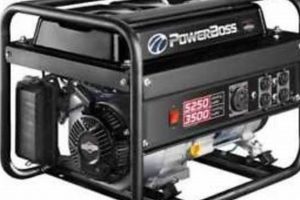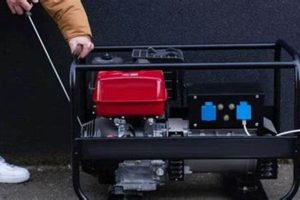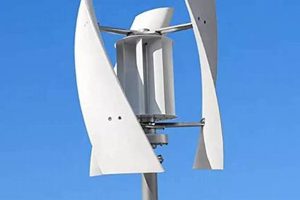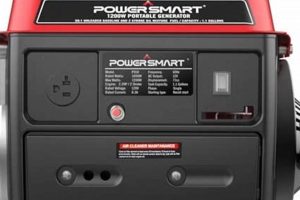Establishing a reliable backup power source for a home or business often involves integrating a portable generator into the electrical system. This integration requires careful planning and professional installation to ensure safety and proper functionality. Expenses associated with this process typically include materials such as transfer switches, wiring, and conduit, in addition to labor costs for the electrician’s expertise. A simple installation might involve connecting a generator directly to critical circuits through an interlock kit, while more complex setups could incorporate a whole-house transfer switch for seamless power transfer during an outage. Understanding these components provides a foundation for accurately estimating the overall financial investment.
Safe and compliant integration of a backup power source is paramount for protecting both the electrical system and individuals. Professional installation mitigates the risks of fire hazards, electrical shocks, and damage to appliances caused by improper wiring or grounding. Furthermore, adhering to local electrical codes and permitting requirements is essential for insurance coverage and future property resale. Historically, backup power solutions were viewed primarily as a safeguard against severe weather events. However, increasing reliance on electricity for essential services and modern conveniences has broadened the need for reliable backup power, highlighting the long-term value of professional installation.
This information serves as an introduction to the various aspects of generator installations. Subsequent sections will delve into specific cost factors, explore different types of generators and transfer switches, and provide guidance on selecting a qualified electrician. Understanding these elements will empower consumers to make informed decisions and ensure a safe and efficient backup power solution.
Tips for Managing Portable Generator Installation Expenses
Careful planning and consideration of various factors can significantly influence the overall expense of integrating a portable generator. The following tips offer guidance for effectively managing these costs.
Tip 1: Obtain Multiple Quotes: Contacting several licensed electricians and requesting detailed quotes allows for comparison of pricing structures and ensures competitive bids. This practice promotes transparency and helps avoid inflated costs.
Tip 2: Evaluate Transfer Switch Options: Different transfer switch types offer varying levels of functionality and complexity. Manual transfer switches are generally less expensive than automatic transfer switches, but require manual operation during a power outage. Careful consideration of individual needs and budget constraints should guide this decision.
Tip 3: Assess Wiring Needs: The distance between the generator and the transfer switch, as well as the number of circuits requiring backup power, directly impacts wiring costs. Accurate assessment of these factors during the planning phase can prevent unexpected expenses.
Tip 4: Consider Permitting Requirements: Researching and obtaining necessary permits before installation can help avoid delays and potential fines. Incorporating permit costs into the budget ensures accurate financial planning.
Tip 5: Explore Pre-Wired Generator Options: Some portable generators come pre-wired for specific transfer switch types, simplifying the installation process and potentially reducing labor costs. Investigating these options can offer cost-effective solutions.
Tip 6: Factor in Long-Term Maintenance: While not directly related to initial installation costs, budgeting for routine maintenance, such as oil changes and filter replacements, ensures the generator’s longevity and prevents costly repairs down the line.
Tip 7: Inquire About Warranty Coverage: Understanding the warranty coverage for both the generator and the installation itself provides peace of mind and protection against unforeseen issues. This information should be factored into the overall cost assessment.
By considering these tips, consumers can gain a comprehensive understanding of the factors influencing installation expenses and make informed decisions that align with their budget and power requirements. Proper planning and execution ensure a safe, compliant, and cost-effective backup power solution.
The following section concludes this exploration of portable generator installation costs by summarizing key takeaways and offering final recommendations.
1. Electrician Fees
Electrician fees represent a substantial portion of the overall expense associated with portable generator installation. These fees encompass labor costs for the electrician’s expertise in assessing the electrical system, installing the transfer switch, connecting the generator inlet, and ensuring compliance with local electrical codes. The complexity of the installation directly influences labor costs. A straightforward installation involving a manual transfer switch and minimal wiring will typically incur lower fees than a complex setup requiring a whole-house automatic transfer switch and extensive wiring throughout the property. For example, connecting a small portable generator to a few essential circuits might require only a few hours of labor, whereas integrating a large generator with a complex transfer switch system could necessitate several days of work.
Several factors contribute to variations in electrician fees. Geographic location plays a role, as labor rates differ across regions. The electrician’s experience and level of expertise also influence pricing. Highly experienced electricians specializing in generator installations often command higher fees due to their specialized knowledge. Furthermore, the availability of electricians in a given area can affect pricing, particularly during periods of high demand, such as after severe weather events. Obtaining multiple quotes from different licensed electricians is crucial for comparing pricing structures and ensuring competitive rates. Detailed quotes should itemize labor costs, materials, and any additional fees to provide transparency and facilitate informed decision-making.
Careful consideration of electrician fees is essential for accurate budgeting and cost management. Understanding the factors influencing these fees allows consumers to anticipate potential expenses and make informed choices. While focusing solely on the lowest price might be tempting, prioritizing experience, proper licensing, and adherence to safety standards ensures a reliable and compliant installation. Investing in a qualified electrician ultimately contributes to the long-term safety and functionality of the backup power system.
2. Transfer Switch Type
Transfer switch selection significantly impacts the overall expense of a portable generator installation. Transfer switches serve as the critical link between the generator, the electrical system, and the utility power grid, ensuring safe and proper power transfer during an outage. Different transfer switch types offer varying levels of functionality, automation, and complexity, directly influencing installation costs. Manual transfer switches, typically less expensive than automatic counterparts, require manual operation during a power outage. This involves physically moving a lever or switch to connect the generator to the designated circuits. Automatic transfer switches, while more expensive, offer greater convenience and safety by automatically detecting a power outage, starting the generator, and transferring power seamlessly. This automated process eliminates the need for manual intervention, enhancing safety and minimizing disruption.
For example, a homeowner installing a portable generator to power essential circuits during an outage might opt for a less expensive manual transfer switch. This choice provides a basic level of functionality at a lower cost. Conversely, a business requiring uninterrupted power for critical operations might choose an automatic transfer switch to ensure seamless power transfer and minimize downtime. This investment prioritizes operational continuity and mitigates potential financial losses due to power disruptions. Furthermore, the complexity of the electrical system and the number of circuits requiring backup power influence the cost of the transfer switch itself and its installation. Whole-house transfer switches, designed to power the entire electrical panel, are generally more expensive than smaller transfer switches intended for specific circuits. The wiring required to connect the transfer switch to the generator and the electrical panel also contributes to the overall installation expense.
Understanding the relationship between transfer switch type and installation cost empowers informed decision-making. Balancing budget constraints with desired functionality is crucial. While manual transfer switches offer a cost-effective solution for basic backup power needs, automatic transfer switches provide enhanced convenience, safety, and operational continuity, justifying the higher cost in certain situations. Careful consideration of individual needs, the complexity of the electrical system, and the long-term value of different transfer switch types ensures a safe, reliable, and cost-effective backup power solution.
3. Wiring and Conduit
Wiring and conduit represent integral components within the overall cost of a portable generator installation. These elements physically connect the generator to the transfer switch and the transfer switch to the electrical panel, facilitating the safe and efficient transfer of power. The type of wiring used, its gauge (thickness), and the length required directly influence material costs. Longer distances between the generator, transfer switch, and electrical panel necessitate more wiring, increasing expenses. Local electrical codes often mandate specific wiring types and gauges for generator installations, impacting material selection and cost. Conduit, the protective casing encasing the wiring, adds further expense. Conduit protects the wiring from physical damage, weather exposure, and potential hazards. Material type (PVC, metal) and length determine conduit costs.
Consider a scenario where a generator is located a significant distance from the house. This increased distance necessitates a longer wiring run, increasing both material and labor costs. Choosing appropriate conduit, such as weather-resistant PVC for outdoor runs, adds further expense but ensures long-term system integrity. Conversely, a shorter distance between components minimizes wiring and conduit needs, reducing overall costs. For example, locating the generator close to the transfer switch and the main electrical panel simplifies the installation and reduces material requirements. Furthermore, installations requiring connection to multiple circuits or a whole-house transfer switch involve more complex wiring configurations, impacting labor and material expenses. These scenarios often necessitate larger gauge wiring to handle the increased electrical load, contributing to higher overall costs.
Understanding the relationship between wiring, conduit, and overall installation cost is crucial for accurate budgeting and project planning. Factors such as distance, wiring type, conduit material, and complexity influence expenses. Careful consideration of these factors during the planning phase ensures efficient material procurement and accurate cost estimation. Choosing appropriate materials that meet local electrical codes while minimizing unnecessary lengths and complexity contributes to a cost-effective and compliant installation.
4. Permits and Inspections
Permits and inspections represent essential components within the overall cost of installing a portable generator. Securing necessary permits from local authorities ensures compliance with building codes and electrical regulations. These permits verify adherence to safety standards designed to protect both individuals and property. Associated fees vary depending on local jurisdictions and the scope of the project. Inspections, conducted by qualified officials, validate the installation’s adherence to code requirements. These inspections confirm proper wiring, grounding, and connection procedures, minimizing potential hazards. Inspection fees contribute to the overall project expense. Failure to obtain necessary permits and inspections can result in fines, delays, and potential invalidation of homeowner’s insurance coverage in case of incidents.
Consider a homeowner installing a portable generator without obtaining the required permits. If an electrical fire originating from the generator installation occurs, insurance claims might be denied due to non-compliance. This scenario highlights the financial and safety implications of circumventing permitting procedures. Conversely, a homeowner diligently securing permits and undergoing inspections can demonstrate adherence to safety standards, facilitating insurance claims processing and protecting their investment. Furthermore, permits and inspections protect property value. When selling a home, documented compliance with building codes and electrical regulations provides assurance to potential buyers, potentially increasing resale value. Unpermitted installations, conversely, can raise concerns and potentially decrease property value.
Understanding the integral role of permits and inspections in portable generator installations ensures project compliance, safety, and long-term value. While these processes contribute to upfront expenses, they offer crucial protection against potential financial and safety risks. Integrating permitting and inspection costs into project budgets allows for accurate cost estimation and avoids potential complications. Adherence to these procedures ensures a safe, compliant, and legally sound installation, contributing to peace of mind and property protection.
5. Generator Connection Accessories
Generator connection accessories represent essential components impacting the overall cost of portable generator installation. These accessories facilitate the safe and compliant connection between the generator and the transfer switch, ensuring proper power transfer during outages. Costs associated with these accessories vary depending on the specific requirements of the installation. Essential accessories typically include an inlet box, a power cord designed for generator use, and potentially a grounding rod. The inlet box, mounted on the exterior of the building, provides a safe and weatherproof connection point for the generator’s power cord. Power cords, specifically designed for generator applications, feature heavy-duty construction and appropriate connectors to handle the electrical load. Grounding rods, driven into the earth, provide a safe path for electrical current to dissipate, preventing shocks and protecting equipment. For instance, a basic installation might require a standard inlet box and a relatively short power cord, while a more complex setup might necessitate a higher-capacity inlet box and a longer, heavier-duty cord, increasing expenses.
Material quality and specific features influence accessory costs. Weatherproof inlet boxes designed for harsh climates typically cost more than standard models. Similarly, heavy-duty power cords with durable connectors command higher prices than lighter-duty cords. The length of the power cord also affects cost, with longer cords requiring more material and thus increasing expenses. Choosing appropriate accessories ensures safe and reliable operation while aligning with budgetary constraints. For example, opting for a weatherproof inlet box in coastal regions prone to salt spray protects the connection from corrosion and extends its lifespan, justifying the higher initial cost. Similarly, selecting a power cord with sufficient length and appropriate gauge prevents voltage drops and ensures efficient power delivery to the transfer switch, optimizing generator performance.
Careful selection and proper installation of generator connection accessories contribute significantly to the safety, reliability, and overall cost-effectiveness of a portable generator installation. Understanding the function and cost implications of each accessory allows for informed decisions that balance performance, safety, and budgetary considerations. While these accessories might represent a smaller portion of the total installation expense, their proper selection ensures the safe and efficient operation of the entire backup power system, protecting both the investment and the individuals relying on it.
Frequently Asked Questions
This section addresses common inquiries regarding the expenses associated with portable generator installations, providing concise and informative responses.
Question 1: What is the typical price range for installing a portable generator?
Installation costs typically range from $500 to $3,000 or more, depending on factors such as transfer switch type, wiring complexity, and local labor rates. Simpler installations involving manual transfer switches and minimal wiring tend toward the lower end of the spectrum, while complex setups incorporating automatic transfer switches and extensive wiring contribute to higher overall costs.
Question 2: Does generator size influence installation cost?
Generator size indirectly affects installation expenses. Larger generators often require heavier-duty wiring, larger transfer switches, and potentially additional permitting, increasing overall costs. Smaller generators, conversely, typically involve less extensive wiring and smaller transfer switches, contributing to lower installation expenses.
Question 3: Are permits always required for portable generator installations?
Permitting requirements vary by jurisdiction. Consulting local authorities is crucial for determining specific requirements and associated fees. Failure to obtain necessary permits can result in fines, delays, and potential issues with insurance coverage.
Question 4: Can homeowners install portable generators themselves?
While some homeowners possess basic electrical skills, professional installation by a licensed electrician is strongly recommended. Incorrect wiring or grounding can create significant safety hazards, including fire and electrocution risks. Professional installation ensures compliance with electrical codes and safeguards against potential dangers.
Question 5: How does transfer switch selection impact cost?
Transfer switch choice significantly influences overall expense. Manual transfer switches, less expensive than automatic counterparts, require manual operation during an outage. Automatic transfer switches offer greater convenience and safety through automated power transfer but come at a higher price point.
Question 6: What factors contribute to variations in electrician fees?
Electrician fees vary based on several factors, including geographic location, experience level, complexity of the installation, and local market demand. Obtaining multiple quotes from licensed electricians facilitates cost comparison and informed decision-making.
Understanding these common cost factors empowers informed decisions regarding portable generator installations. Careful planning, budgeting, and professional consultation ensure safe, compliant, and cost-effective backup power solutions.
This concludes the frequently asked questions section. The following section offers a summary of key takeaways and concluding recommendations.
Conclusion
Careful evaluation of expenses associated with portable generator installations is crucial for informed decision-making. Factors influencing overall costs include electrician fees, transfer switch selection, wiring and conduit requirements, necessary permits and inspections, and generator connection accessories. Each component contributes significantly to the total investment, and understanding these individual cost drivers empowers consumers to make choices aligned with both budgetary constraints and desired functionality. Professional consultation with licensed electricians is essential for accurate cost estimation, system design, and compliant installation. Balancing upfront expenses with long-term value ensures a safe, reliable, and cost-effective backup power solution.
Investing in a properly installed portable generator provides peace of mind and protection against power disruptions. While cost considerations are important, prioritizing safety, compliance with regulations, and long-term system reliability ensures a valuable investment that safeguards homes and businesses for years to come. Thorough planning, professional guidance, and informed decision-making contribute to a resilient and secure power infrastructure.






